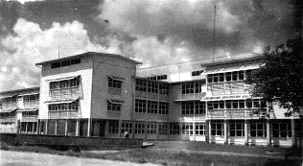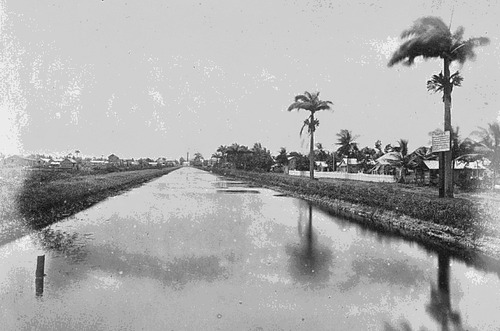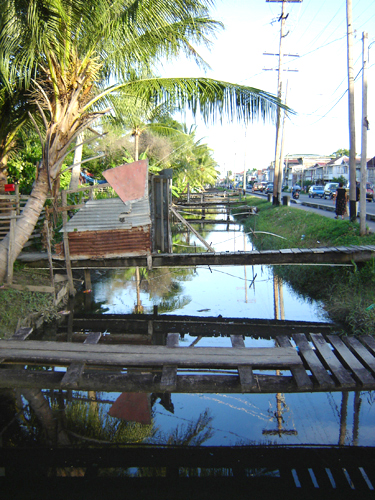By now I had started to attend school - St. Thomas’s School - more commonly known as Sharples School. My two older brothers also attended this school and Jack, the eldest, received a free place at Queens College having won a Mitchell scholarship. He was truly the brainy one.

There are many memories of these school days that still linger with me. It was certainly the largest school in Georgetown and definitely the most outstanding. Sharples school was notorious for turning out the most prominent judges, lawyers, doctors and people of real quality and this was only possible because of the competence and discipline of teachers like De Weever, Blackman, Spooner, Marshall and Weeks, serving under the mastermind of the headmaster, Daniel Sharples. My sister Edna and brother Frankie were still too young to attend school.
My recollections of life at this period were still scant, but I do recall some very salient points. This was about the year 1914.
As there was no pure water supply nor a sewerage disposal system in the city of Georgetown, the water which was drunk was collected from the rainfall on house roofs, and stored in wooden vats in the yard from which the supply was drawn off via stopcocks. This roof washing was run into the vats by means of guttering and pining, and since most of the roofs were constructed of galvanised corrugated sheeting, when it rained, the din created by the tropical downpours was quite something to hear. The final bit of piping which connected roof to vat was placed over a 12 inch square of fine wire mesh, which prevented leaves and other bits of stuff from being washed off the roof into the vat.
These vats created a grave health hazard to the population, as mosquitoes inevitably found their way through openings at the top end, laid their eggs, and bred very profusely. The Anopheles mosquito was the most unwelcome species, and at that time, malaria was a very prevalent disease.
I can remember the method then employed by the city health service of introducing live little fishes into the vats to consume the eggs and larvae of the mosquitoes. There was, however, piped water in the city of Georgetown, but it was not notable. It was pumped straight from the Lamaha Canal - a man-made canal - and connected to the houses. Usually there were connections to the kitchen sink for dishwashing, to the bathroom for showering and also in the yard at ground level.

The colour of the water was brown, as the Lamaha Canal was an open reservoir into which leaves and vegetable matter fell and decayed, imparting a rich brown colour to the water. It did not pass through any purification system. In times of drought when the stored water supply in the vats ran out, individual attempts would be made to decolourise and purify the Lamaha “pine-water” so as to make it fit for drinking.

There was no sewerage system at this time either, and it was quite common to have to use an outhouse in the yard to dispose of body wastes. The better homes were equipped with flush toilets leading to septic tanks, which required individual attention by the respective owners.
As regards the outhouses, these were just little huts built over a cesspool into which faecal matter was deposited direct from the body. By today’s standards this condition would be quite impossible in a city, but then, it did not seem to bother anyone. When these cesspits became full, arrangements would be made to have the stuff pumped out, and a city excavator would be sent to take care of the situation. The excavator was in reality a tank truck and it carried hoses which ware inserted into the pit. Then a suction pump would be started and the matter drawn out from the pit into the tank-truck. I have seen this done both manually, using a large hand operated pump manned by four to six men, and also by means of the engine power of the truck.
Either way, it was a messy operation especially if the connected hoses (somewhat like oversize hoses of fire engines) developed a leak, or worse, if one of them should burst! It was common practice for the crew of the excavator to use a large smokepot on the top of the vehicle during the operation to help mask the malodorous effluvium. What a contrast today to find Georgetown with a robot sewerage system, and a sophisticated potable water supply!
The rain water vats have long since gone and the disease malaria, completely eradicated. This was also a period of great poverty for my family, and it is truly amazing how we existed on the small pittance we received. We were forced to live on the barest necessities, but fortunately we managed to survive, and even seemed to keep good health. Who knows? - perhaps we survived because of the simplicity of our lives.
As I said, we lived in a small house in Cummings Street and the Queenstown area was not very far away. At that time, however, Queenstown was mostly a series of open fields in which people who owned cows and other cattle would let them graze. Children would go there at Easter time to fly their kites, and having a lot of wide open spaces, boys in particular would go there and play “bat and ball” - a modified children’s version of the game of cricket. I recall quite distinctly how one evening my brother Jack, then a teenager, returned home from one of his frequent visits to these Queenstown playing fields covered with cow dung and smelling quite offensive. It turned out that he was involved in a fight with other boys there, and for ammunition they used heaps of partially sun baked cow excrete, the tops of which would be firm but the underside quite moist, warm and really smelly. Did Jack stink!!
By the time I attained the age of nine, our old guardian, Mrs. McAllister, whom we called “Da-Da”, died, and this brings me to another turning point of my life.
No comments:
Post a Comment